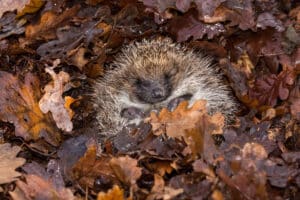Gardeners can help birds, insects and frogs survive the cooler months with some simple steps, say experts.

It may have been a mild autumn, but as soon as temperatures drop, wildlife garden visitors will be looking for places to hunker down for hibernation. Hedgehogs, birds, amphibians and insects all need a helping hand, and here are a few of the things you could be doing to give them the best chance of survival during the cooler months.
Give a boost to birds
“Whether you have a garden, balcony, or doorstep, the simplest way to help birds is to put out supplementary food.
Sunflower hearts, peanuts, nyjer seed and fatty nibbles will all go down a treat with a range of birds, but do make sure you keep feeding areas clean and hygienic,” says Adrian Thomas, RSPB wildlife gardening expert.
“Try putting out some of your leftovers – mild grated cheese, dried fruit, and pastry with real fats will give them an extra energy boost.”
Plant shrubs, trees, and climbing plants to boost their natural food sources, he adds. If you choose your plants well, in time they will provide berries, nuts and seeds through many of the coldest months of the year, and vital protein such as insects and their eggs. Keep birds hydrated by incorporating a birdbath into your open space, which will also keep their feathers in good condition.
Finally, there’s shelter. If you’ve planted shrubs or trees, they will be an invaluable roosting space for many birds, while nest boxes can also help.
“You might even see multiple birds bunking up – wrens, for example, are normally pretty solitary, but in the winter they’ll happily huddle together to stay warm,” he says.
Create a hedgehog hideaway
Like birds, hedgehogs will be now foraging as much food as they can to see them through the cooler months, and are particularly partial to meaty cat or dog food and kitten biscuits, says Grace Johnson, hedgehog officer for campaigning group Hedgehog Street.
“As they enter the hibernation season they need to put on a lot of body fat to be able to last through winter,” she says. “Put the food away from the house as they may be nervous about coming too close to lights or noise. It’s a good idea to put the food into a feeding station such as an upturned storage box, cutting a small entrance for the hedgehog but keeping cats and foxes out.
“Hedgehogs are faring better in urban and suburban areas because our gardens can create a variety of habitats for them. If you make a little gap in your fence to give them access you may well see them,” she adds.
Compost heaps and log piles provide good hibernation retreats, but hedgehogs will also be building hibernation nests, known as hibernacula, she points out, so leave a wild patch in your garden where they will make use of leaves and twigs.
You may even leave out some straw for them to use, or place a hedgehog house (which you can buy) in an undisturbed patch.
Planting low-growing dense shrubs also creates shelter for hedgehogs, as well as native plants such as bird’s foot trefoil, vetches, hawthorn and hazel, she adds.
Don’t forget frogs
“Being cold-blooded, [frogs] basically park up and close shop for the winter months,” explains Sean McMenemy, founder and managing director of wildlife products specialist Ark Wildlife.
“Their metabolism slows down to a point where they won’t be digesting. They just stop feeding. The male frogs will go to the bottom of a pond in winter, so even if you don’t have fish it’s a good idea to put a ball on the surface of a pond to stop it freezing over.”
Amphibians will also shelter in log piles, but you need to protect them from frost.
“I dig a small pit filled with stones with plenty of spaces,” he says. “Either bricks which are offset or bricks with holes in, or rough edged stones give you lots of air gaps. Dig the hole about 8in and backfill it with rocks and cover it loosely with soil – it just gets them out of the frost zone.”
Make a shelter for insects
“One of the most common things you find in gardens now are solitary bee (nesting) tubes with holes drilled into them,” McMenemy explains. These are often hung on trees or mounted on south-facing walls or fences and hold the larvae, which will hatch out the following spring.
“If you have them and the bees have nested – you can tell if they’ve used them because they will either have a leafy cap on the top if they are leaf cutters or bits of soil stuck to the top – take them in and put them in a garage or shed over winter, to protect them from the worst of the cold and from predatory birds. Take them outside again in March.”
The last of the queen bumblebees will now be evident in gardens, looking for hibernation quarters, he says. Hollows in tree trunks
or holes in the ground provide ideal conditions. Leave late-flowering plants to do the last of their blooming, which will give bees the additional energy they need before winter.
Beetles need multiple habitats in one – a wet pile and a dry pile – he suggests. Again, digging a hole with stones and offset bricks will protect many insects over the winter. Dig it in a south-facing spot, where the grubs will look for the morning sun come spring, he says.
If you want to go DIY, fill an empty cereal box with newspaper and hang it upside down or line an unused nest box with torn-up newspaper to make an overwintering site for insects. Or fill a clean jar with old newspaper and hang it upside down on a bamboo cane to give overwintering butterflies and moths shelter, he suggests.
(Article source: Silver Surfers)

